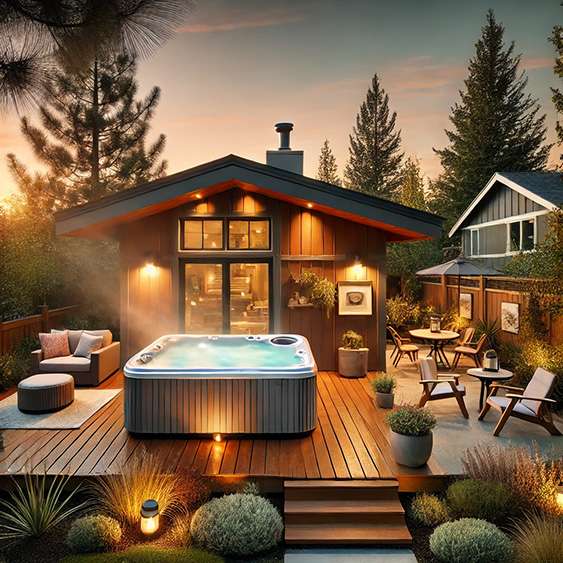When it comes to hydrotherapy and relaxation, several terms are often used interchangeably: spas, hot tubs, Jacuzzis, and whirlpools. While they all provide soothing, therapeutic experiences, significant distinctions exist between them. Understanding the differences will help you make an informed decision on which option best meets your needs. In this article, we’ll explore each type in-depth, examine their history, benefits, and practical uses, and guide you in choosing the perfect hydrotherapy solution.
The History of Hydrotherapy
Hydrotherapy, or water-based therapy, has been used for thousands of years to relieve pain, promote relaxation, and improve health. Ancient civilizations, including the Egyptians, Greeks, and Romans, were known to use hot baths and therapeutic water treatments as part of their healing processes. Public bathhouses were common in ancient Rome, where people gathered to bathe, socialize, and rejuvenate.
In more modern times, hydrotherapy has evolved with technological advancements, leading to the development of hot tubs, Jacuzzis, and whirlpool systems. With a rich history rooted in wellness, the concept of water therapy remains integral to relaxation and health today.

Spas: The Ultimate Wellness Destination
When people think of a “spa,” they often envision a luxury retreat offering various treatments for relaxation and rejuvenation. The term “spa” has evolved from its original meaning, which referred to a place where mineral-rich spring waters were used for therapeutic bathing. Today, the word encompasses a broad range of wellness-focused facilities that offer services beyond just water therapy.
Types of Spas
Spas can be divided into several categories, including:
1. Day Spas:
These are standalone facilities where clients can book individual treatments, such as massages, facials, and body scrubs. Hydrotherapy features like steam rooms, saunas, and hot tubs are often included in day spa services.
2. Destination Spas
These are retreats where guests stay for a specific amount of time to focus on relaxation, health, and wellness. These spas typically offer a wide range of services, including fitness classes, specialized diet plans, wellness education, and traditional spa treatments.
3. Medical Spas:

These facilities offer a mix of medical treatments and spa therapies, often under the supervision of a licensed healthcare professional. Services may include advanced skincare, laser treatments, physical therapy, and relaxing massages or facials.
4. Resort and Hotel Spas:
These are spas located within hotels or resorts, offering a combination of lodging and spa services. Guests can enjoy both leisure and wellness activities, making it a popular option for travelers.
Hydrotherapy at Spas
Most spas feature some form of hydrotherapy, whether through hot tubs, pools, whirlpools, or other water treatments. The main goal of hydrotherapy at a spa is to relax the muscles, improve circulation, and enhance overall wellness. Hot tubs in spa settings often come with extra features such as aromatherapy, chromotherapy (light therapy), and sound systems to create a multi-sensory experience.
Spas offer more than hydrotherapy, making them a broader wellness option than hot tubs, designed specifically for water-based relaxation and therapy. So if you’re seeking a more holistic approach to wellness, which includes massages, skincare, and even fitness programs, a spa could be your ideal destination.
Hot Tubs: A Self-Contained Hydrotherapy Experience
Hot tubs, on the other hand, are specifically designed for relaxation and hydrotherapy. These self-contained units are filled with water, heated to a comfortable temperature (usually between 100°F and 104°F), and equipped with jets that massage the body, providing both therapeutic and recreational benefits.
Materials and Design of Hot Tubs
Hot tubs come in various materials and designs to suit individual preferences:
1. Acrylic:
Most modern hot tubs are made of acrylic, a durable and flexible material that can be molded into different shapes and sizes. Acrylic hot tubs are popular due to their durability, smooth surface, and ease of maintenance.
2. Fiberglass:
Another common material for hot tubs, fiberglass, is lightweight and strong. It’s often used as a backing material for acrylic hot tubs to add structural support.
3. Wood:
Traditional wooden hot tubs, often made from cedar or redwood, have a natural, rustic appeal. Although they don’t have the same level of insulation or modern features as acrylic hot tubs, many people appreciate their aesthetic and old-world charm.
4. Vinyl-Lined:
Some hot tubs, especially inflatable models, are lined with vinyl. These are typically more affordable and portable, making them a good option for temporary or budget-friendly solutions.
Features and Benefits of Hot Tubs
Modern hot tubs are equipped with a range of features designed to enhance relaxation and hydrotherapy, such as:
1. Jets:
A hot tub’s primary function is to provide massage through jets that can target specific areas of the body. Jets vary in size and strength, allowing users to customize their experience.
2. Temperature Control:
Hot tubs allow users to control the water temperature to their preference. Warmer water helps relax muscles, improve circulation, and relieve pain.
3. Lighting and Sound Systems:
Many hot tubs have built-in lighting and Bluetooth sound systems, which create a calming ambiance and enhance the overall experience.
4. Saltwater Systems:
Some hot tubs use salt water instead of traditional chlorine for water sanitation, providing a gentler, more natural soaking experience.
The primary purpose of a hot tub is hydrotherapy, whether for relaxation, stress relief, or physical rehabilitation. Unlike a spa, which offers a variety of treatments, a hot tub focuses solely on water therapy, making it an excellent choice for those looking for targeted hydrotherapy at home.
Jacuzzis: The Household Name for Hydrotherapy
Jacuzzi is a brand name that has become synonymous with hot tubs, much like how Kleenex is used to refer to tissues. The Jacuzzi brothers were pioneers in the development of hydrotherapy, initially inventing a pump in the 1950s that could be used in bathtubs to create a therapeutic whirlpool effect. Since then, Jacuzzi has become a household name in the hydrotherapy industry.
The History of Jacuzzi
The Jacuzzi story began in 1915 when seven Italian immigrant brothers founded a company that originally focused on aircraft propellers. However, the turning point for Jacuzzi came when one of the brothers, Candido, invented the first portable hydrotherapy pump to help treat his son’s rheumatoid arthritis. The pump could be placed in any bathtub, transforming it into a therapeutic whirlpool. This invention laid the foundation for what would become one of the most recognizable spa and hot tub brands.
By the 1960s, Jacuzzi was manufacturing self-contained, built-in whirlpool baths. These products quickly became popular for therapeutic purposes and as a luxury feature for home bathrooms. Today, Jacuzzi offers a wide range of products, including hot tubs, whirlpools, showers, and saunas.
Why People Use the Term "Jacuzzi" for Hot Tubs
Because Jacuzzi was the first major company to popularize hydrotherapy tubs, many people use the term “Jacuzzi” to refer to any hot tub, regardless of the brand. However, it’s important to note that Jacuzzi is a brand, and not all hot tubs are Jacuzzis. If you’re specifically looking for a Jacuzzi-brand product, verifying the brand name when purchasing is important.
Jacuzzi tubs are often associated with high-end luxury and advanced features, making them a popular choice for consumers who want the best in hydrotherapy technology. The brand continues to innovate in the field of hydrotherapy, offering products that focus on comfort, style, and wellness.
Whirlpools: The Hydrotherapy Experience
A whirlpool is a type of hydrotherapy tub that uses jets to create a swirling current of water, providing a therapeutic massage effect. Like hot tubs, whirlpools can be found in homes, hotels, spas, and physical therapy clinics. The swirling water stimulates circulation, relieves tension, and soothes sore muscles.
Whirlpool vs. Hot Tub: What's the Difference?
While hot tubs and whirlpools may seem similar, they have some key differences. The term “whirlpool” generally refers to the water movement and jet action within the tub. You can think of a whirlpool as a feature within a hot tub or bathtub that creates a circular water motion. In contrast, a hot tub refers to a self-contained unit providing heated water and therapeutic jets. Essentially, a hot tub may have whirlpool functionality, but a whirlpool is a specific type of water action.
Whirlpools are often found in therapy clinics, as they are used in rehabilitation treatments for injuries and chronic pain. Many homeowners install whirlpool baths in their bathrooms for personal hydrotherapy, but they do not have the same social and entertainment functions as outdoor hot tubs.
Types of Whirlpools
Whirlpools come in different designs depending on their intended use:
1. Bathtub Whirlpools:
These are commonly found in bathrooms and combine the features of a regular bathtub with jets for a relaxing whirlpool experience. They are generally smaller and meant for one or two people.
2. Whirlpool Baths:
Larger than standard bathtubs, whirlpool baths offer more space and stronger jets, often with advanced features like chromotherapy and aromatherapy options. These are typically installed in luxury bathrooms or wellness centers.
3. Physical Therapy Whirlpools:
These are specialized whirlpools used in rehabilitation centers to treat patients recovering from injuries or surgeries. They are designed with therapeutic goals in mind and often have precise controls for temperature and water flow.
Comparing the Options: Which One is Right for You?
Now that we’ve explored the differences between spas, hot tubs, Jacuzzis, and whirlpools, how do you decide which is the best option for you? Here are a few key considerations to keep in mind when making your choice:
1. Purpose and Goals
- A spa might be your best option if you’re looking for a complete wellness experience that includes massage, skincare, and hydrotherapy.
- A hot tub is an excellent choice if you want to bring hydrotherapy into your home for regular relaxation and muscle relief. These can be used year-round, both indoors and outdoors.
- If you’re specifically looking for a high-end brand known for its quality and innovation, Jacuzzi offers top-tier hot tubs and whirlpool baths that combine luxury and functionality.
- If your focus is on therapeutic treatments, especially for pain relief and rehabilitation, a whirlpool system could provide the most targeted benefits in physical therapy or at home.
2. Location and Space
- Spas are typically standalone facilities, so you must travel to experience their services. This may not be the most convenient option if you prefer to have your relaxation experience at home.
- Hot tubs can be installed indoors or outdoors, making them a versatile option for homeowners. They come in various sizes and shapes, so you can choose one that fits your available space.
- Jacuzzis offers a range of products, from indoor whirlpool baths to outdoor hot tubs, allowing you to choose the right solution for your space.

- Whirlpools are generally smaller and meant for indoor use, so they’re ideal for those who want hydrotherapy in a bathroom setting.
3. Maintenance and Cost
- Hot tubs and Jacuzzis require regular maintenance, such as water testing, cleaning, and changing filters. While they can be an investment, they offer long-term benefits and are relatively easy to maintain with proper care.
- Whirlpools used in therapy clinics or bathrooms may require less maintenance since they aren’t used as frequently as outdoor hot tubs, but they still need regular cleaning.
- Spas, being commercial facilities, handle all the maintenance for you, which is why they can be a more expensive option.
Conclusion: Choosing the Right Hydrotherapy Solution
In conclusion, spas, hot tubs, Jacuzzis, and whirlpools all offer unique hydrotherapy experiences, but they are not the same. Spas provide a broad range of wellness treatments, while hot tubs focus solely on hydrotherapy. Jacuzzi is a luxury brand known for its innovation in hydrotherapy, and whirlpools are specifically designed to create a swirling water current for therapeutic purposes.
When choosing between these options, consider your goals, available space, and budget. Whether you’re looking for pain relief, improved circulation, or simply a way to unwind, there’s an option that will suit your needs.
If you have any questions or want to visit our showroom, give us a call here at Love’s Hot Tubs. We look forward to helping you choose the perfect hydrotherapy solution for your lifestyle.

